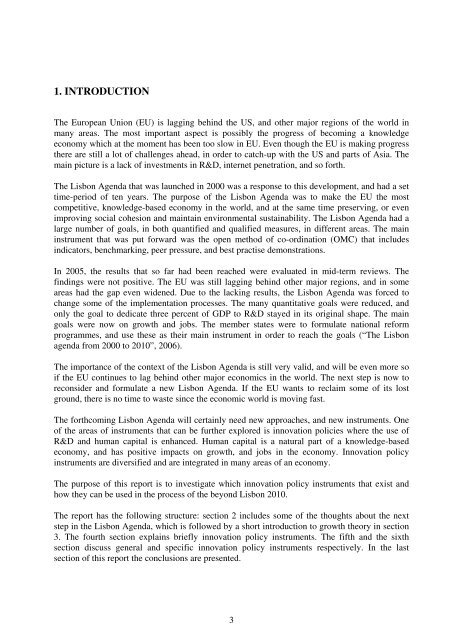INNOVATION POLICY INSTRUMENTS
INNOVATION POLICY INSTRUMENTS
INNOVATION POLICY INSTRUMENTS
Create successful ePaper yourself
Turn your PDF publications into a flip-book with our unique Google optimized e-Paper software.
1. INTRODUCTION<br />
The European Union (EU) is lagging behind the US, and other major regions of the world in<br />
many areas. The most important aspect is possibly the progress of becoming a knowledge<br />
economy which at the moment has been too slow in EU. Even though the EU is making progress<br />
there are still a lot of challenges ahead, in order to catch-up with the US and parts of Asia. The<br />
main picture is a lack of investments in R&D, internet penetration, and so forth.<br />
The Lisbon Agenda that was launched in 2000 was a response to this development, and had a set<br />
time-period of ten years. The purpose of the Lisbon Agenda was to make the EU the most<br />
competitive, knowledge-based economy in the world, and at the same time preserving, or even<br />
improving social cohesion and maintain environmental sustainability. The Lisbon Agenda had a<br />
large number of goals, in both quantified and qualified measures, in different areas. The main<br />
instrument that was put forward was the open method of co-ordination (OMC) that includes<br />
indicators, benchmarking, peer pressure, and best practise demonstrations.<br />
In 2005, the results that so far had been reached were evaluated in mid-term reviews. The<br />
findings were not positive. The EU was still lagging behind other major regions, and in some<br />
areas had the gap even widened. Due to the lacking results, the Lisbon Agenda was forced to<br />
change some of the implementation processes. The many quantitative goals were reduced, and<br />
only the goal to dedicate three percent of GDP to R&D stayed in its original shape. The main<br />
goals were now on growth and jobs. The member states were to formulate national reform<br />
programmes, and use these as their main instrument in order to reach the goals (“The Lisbon<br />
agenda from 2000 to 2010”, 2006).<br />
The importance of the context of the Lisbon Agenda is still very valid, and will be even more so<br />
if the EU continues to lag behind other major economics in the world. The next step is now to<br />
reconsider and formulate a new Lisbon Agenda. If the EU wants to reclaim some of its lost<br />
ground, there is no time to waste since the economic world is moving fast.<br />
The forthcoming Lisbon Agenda will certainly need new approaches, and new instruments. One<br />
of the areas of instruments that can be further explored is innovation policies where the use of<br />
R&D and human capital is enhanced. Human capital is a natural part of a knowledge-based<br />
economy, and has positive impacts on growth, and jobs in the economy. Innovation policy<br />
instruments are diversified and are integrated in many areas of an economy.<br />
The purpose of this report is to investigate which innovation policy instruments that exist and<br />
how they can be used in the process of the beyond Lisbon 2010.<br />
The report has the following structure: section 2 includes some of the thoughts about the next<br />
step in the Lisbon Agenda, which is followed by a short introduction to growth theory in section<br />
3. The fourth section explains briefly innovation policy instruments. The fifth and the sixth<br />
section discuss general and specific innovation policy instruments respectively. In the last<br />
section of this report the conclusions are presented.<br />
3
















